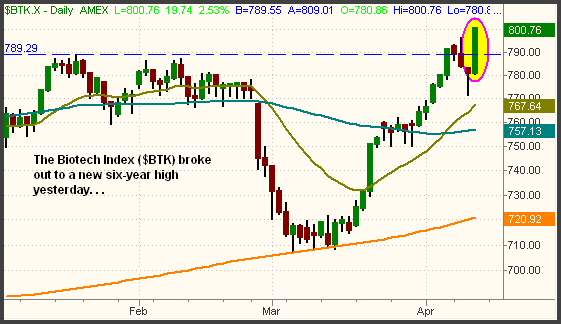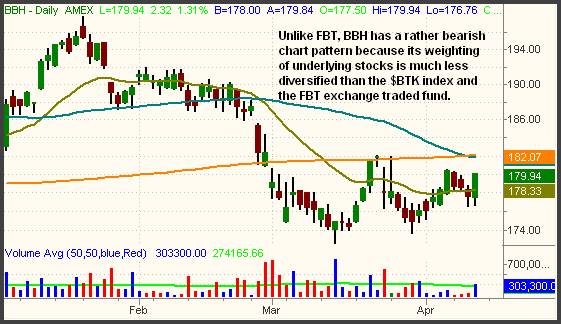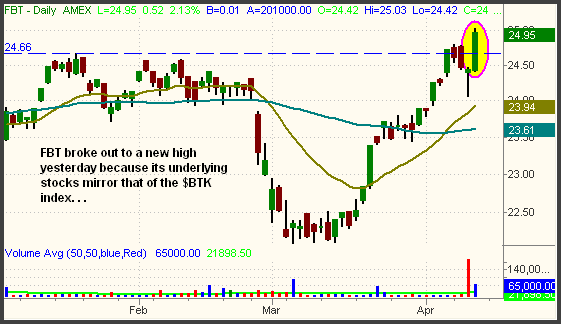|
The Wagner Daily ETF Report for April 13
The market demonstrated its resiliency yesterday, as the major indices recovered virtually all of their previous day's losses. Stocks initially gapped lower on follow-through weakness from the prior session, but buyers quickly stepped up to the plate, causing the broad market to trend steadily higher throughout the day. Both the S&P 500 and Dow Jones Industrial Average rallied 0.6%, while the Nasdaq Composite gained 0.9%. The Nasdaq reversed all of its losses from the previous day and then some. The S&P and Dow made up all but 0.1%. The small-cap Russell 2000 advanced 0.8% and the S&P Midcap 400 closed 0.7% higher. It was a strong close, as all the major indices finished at their intraday highs.
The only thing missing from yesterday's bullish reversal was higher volume. Total volume in the NYSE receded 6%, while volume in the Nasdaq came in 3% below the previous day's level. Considering that Wednesday was a bearish "distribution day" of higher volume losses, it's negative that stocks bounced back on lower turnover. Nevertheless, despite Wednesday's institutional selling, overall turnover has remained below average for several weeks. The NYSE has had fourteen consecutive days of lighter than average volume. Similarly, volume in the Nasdaq has registered below its 50-day average for fifteen straight days. This tells us that institutional traders, both bulls and bears, have remained largely on the sidelines. Frankly, we can't blame them, as the market could rapidly move in either direction from these pivotal levels.
It has been volatile in recent months, but the Biotech Index ($BTK) surged 2.5% and broke out to a new six-year high yesterday. Below is a daily chart of the index:

Although the $BTK index broke out to a new multi-year high, most of the ETFs that track the Biotech index have not done so. The five Biotech ETFs we track are: Biotech HOLDR (BBH), iShares Nasdaq Biotech (IBB), PowerShares Dynamic Biotech (PBE), streetTRACKS Biotech (XBI), and First Trust Biotech (FBT). Ironically, only FBT broke out to a new high along with the $BTK index. While many ETF families of other sectors consist of the same leading stocks, we have found that the Biotech ETFs are vastly different in the composition of their underlying stocks. The variance in their composition has caused significantly different chart patterns to form amongst the group. The reason FBT broke out to a new multi-year high is because it is designed to mirror the stocks and percentage weightings of the $BTK index itself. Only twenty different stocks comprise the $BTK index (and FBT), but each stock has no greater a weighting than 6%. By comparison, BBH consists of only sixteen stocks, and is much more heavily weighted in only a few large-cap Biotech stocks. Amgen (AMGN) and Genentech (DNA) currently comprise a whopping 60% of the portfolio. With the recent under-performance in both of these stocks, it's no wonder that the chart of BBH is rather bearish. As you can see, the daily charts of FBT and BBH bear no resemblance to one another, even though they both track the same sector:


As we have mentioned numerous times over the years, it's important to compare the relative performance of all the ETFs within a particular sector before blindly buying the first sector ETF that comes to mind. If you have not already done so, please download the free Morpheus ETF Roundup to assist you with this.
Some of the sector ETFs such as FBT have a low average daily volume, but remember that liquidity is not really an issue with ETFs. Unlike individual stocks, in which liquidity can greatly affect how a stock trades, all exchange traded funds are synthetic instruments. As such, the amount of average daily volume that an ETF trades is, for the most part, irrelevant. Even if a particular ETF had no buyers or sellers for several hours, the bid and ask prices would continue to move in correlation with the market value of the ETF that is derived from the prices of the underlying stocks. An ETF with a low average daily volume may sometimes have slightly wider spreads between the bid and ask prices, but you can simply use limit orders if this is the case. We trade for points, not pennies, so paying a few cents more on occasion is not a big deal.
In yesterday's newsletter, we illustrated how the major indices closed Wednesday's session at or just above substantial support levels and predicted a tug-of-war between the buyers and sellers in the coming days. Looking at charts of the past two days, one could definitely conclude there is some arguing going on! Unfortunately, yesterday's gains put the major indices in "no man's land," trapped between the numerous support levels we outlined and resistance of last week's highs. The Nasdaq actually closed just above last week's highs, but not by a wide enough margin to definitively declare a breakout to another leg up. The reaction to the onslaught of corporate earnings reports over the next several weeks are likely to be the determining factor of the market's next move.
Deron Wagner is the Founder and Head Trader of both Morpheus Capital LP, a U.S. hedge fund, and Morpheus Trading Group, a trader education firm launched in 2001 that provides daily technical analysis of the leading ETFs and stocks. For a free trial to the full version of The Wagner Daily or to learn about Wagner's other services, visit MorpheusTrading.com or send an e-mail to deron@morpheustrading.com.
|